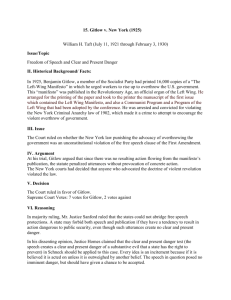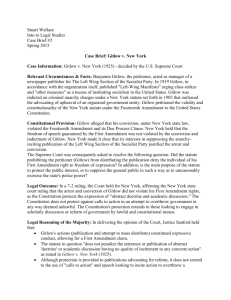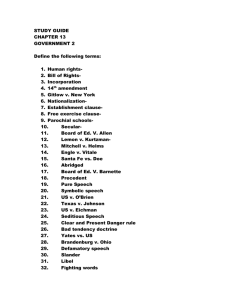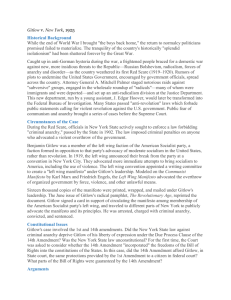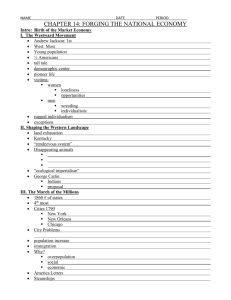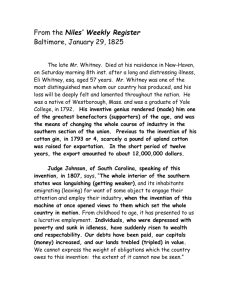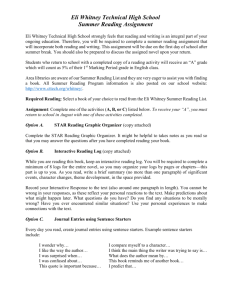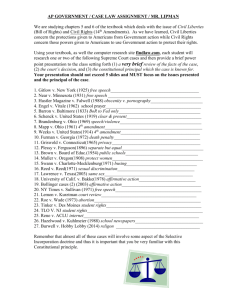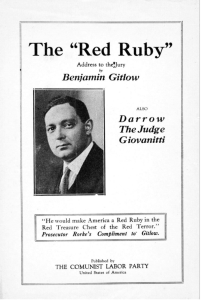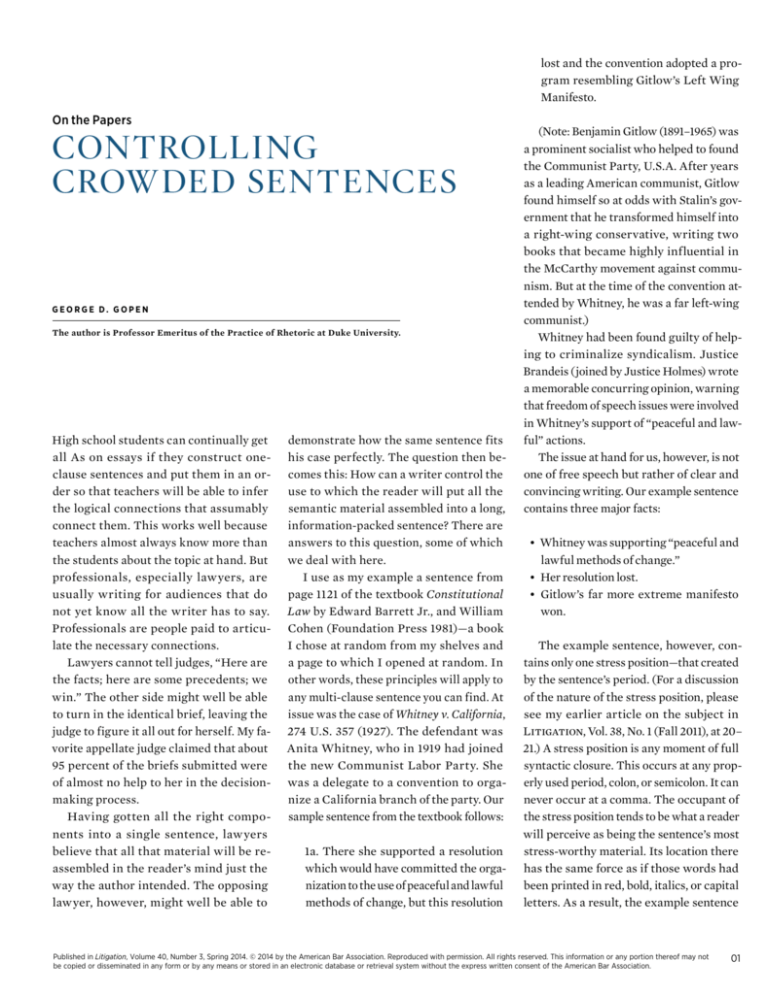
lost and the convention adopted a program resembling Gitlow’s Left Wing
Manifesto.
On the Papers
Controlling
Crow ded Sentences
George D. Gopen
The author is Professor Emeritus of the Practice of Rhetoric at Duke University.
High school students can continually get
all As on essays if they construct oneclause sentences and put them in an order so that teachers will be able to infer
the logical connections that assumably
connect them. This works well because
teachers almost always know more than
the students about the topic at hand. But
professionals, especially lawyers, are
usually writing for audiences that do
not yet know all the writer has to say.
Professionals are people paid to articulate the necessary connections.
Lawyers cannot tell judges, “Here are
the facts; here are some precedents; we
win.” The other side might well be able
to turn in the identical brief, leaving the
judge to figure it all out for herself. My favorite appellate judge claimed that about
95 percent of the briefs submitted were
of almost no help to her in the decisionmaking process.
Having gotten all the right components into a single sentence, lawyers
believe that all that material will be reassembled in the reader’s mind just the
way the author intended. The opposing
lawyer, however, might well be able to
demonstrate how the same sentence fits
his case perfectly. The question then becomes this: How can a writer control the
use to which the reader will put all the
semantic material assembled into a long,
information-packed sentence? There are
answers to this question, some of which
we deal with here.
I use as my example a sentence from
page 1121 of the textbook Constitutional
Law by Edward Barrett Jr., and William
Cohen (Foundation Press 1981)—a book
I chose at random from my shelves and
a page to which I opened at random. In
other words, these principles will apply to
any multi-clause sentence you can find. At
issue was the case of Whitney v. California,
274 U.S. 357 (1927). The defendant was
Anita Whitney, who in 1919 had joined
the new Communist Labor Party. She
was a delegate to a convention to organize a California branch of the party. Our
sample sentence from the textbook follows:
1a. There she supported a resolution
which would have committed the organization to the use of peaceful and lawful
methods of change, but this resolution
(Note: Benjamin Gitlow (1891–1965) was
a prominent socialist who helped to found
the Communist Party, U.S.A. After years
as a leading American communist, Gitlow
found himself so at odds with Stalin’s government that he transformed himself into
a right-wing conservative, writing two
books that became highly influential in
the McCarthy movement against communism. But at the time of the convention attended by Whitney, he was a far left-wing
communist.)
Whitney had been found guilty of helping to criminalize syndicalism. Justice
Brandeis (joined by Justice Holmes) wrote
a memorable concurring opinion, warning
that freedom of speech issues were involved
in Whitney’s support of “peaceful and lawful” actions.
The issue at hand for us, however, is not
one of free speech but rather of clear and
convincing writing. Our example sentence
contains three major facts:
• Whitney was supporting “peaceful and
lawful methods of change.”
• Her resolution lost.
• Gitlow’s far more extreme manifesto
won.
The example sentence, however, contains only one stress position—that created
by the sentence’s period. (For a discussion
of the nature of the stress position, please
see my earlier article on the subject in
Litigation, Vol. 38, No. 1 (Fall 2011), at 20–
21.) A stress position is any moment of full
syntactic closure. This occurs at any properly used period, colon, or semicolon. It can
never occur at a comma. The occupant of
the stress position tends to be what a reader
will perceive as being the sentence’s most
stress-worthy material. Its location there
has the same force as if those words had
been printed in red, bold, italics, or capital
letters. As a result, the example sentence
Published in Litigation, Volume 40, Number 3, Spring 2014. © 2014 by the American Bar Association. Reproduced with permission. All rights reserved. This information or any portion thereof may not
be copied or disseminated in any form or by any means or stored in an electronic database or retrieval system without the express written consent of the American Bar Association.
01
above (for most readers) calls our attention
ful methods of change. This resolution
to the victory of the Gitlow manifesto above
lost. Instead, the convention adopted a
the rest of its contents.
program resembling Gitlow’s Left
What if that was not the authors’ intenWing Manifesto.
tion? None of their words, nor their facts,
would be incorrect; and yet most readers
I do not hold with those who advise
would read the sentence in a way that was “to make it better, make it shorter.” The
not in accord with the authorial intention. brevity of these sentences is not their
As writers, we have effective ways to control strength; it represents rather their equalwhat most readers will tend to emphasize. ity of weight and focus.
These ways are not 100 percent surefire. Any
avid pro-communist or anti-communist or
free-speech reader might well find what he Variation No. 2
or she wants to find. But for the 90-plus per- If, instead, the authors had wished us to
cent of the readers who are trying their best understand that Whitney’s losing and
to understand what the authors are trying Gitlow’s winning should attract our attento say, the reader expectations about giving tion equally—even though the two stateextra emphasis to material in stress positions
ments about winning and losing add up
will carry the interpretive day.
to the same result—then they could have
Again—no “rules” here. Each of the revi- accorded her effort a stress position by the
sions that follow here will affect most read- use of a colon. A colon followed by a main
ers most of the time—which is a great im- clause (one able to stand by itself as a senprovement over letting the readers figure
tence) functions as a kind of “equals” sign.
out how to assemble the 36 words for them- It states, “I’m saying the same thing again,
selves. Many Plain English experts claim a
but in a different way.” In these cases, the
sentence is too hard to read if it exceeds 29 colon should be followed by a capital letter,
words. That is wrong. After 29 words, sen- which warns the reader to expect a main
tences just become harder to write. Clear clause—and not just a list of examples. (The
writing can produce clear sentences of well latter is the more common use of the colon.)
more than 100 words.
So let us look at four revisions of this sen1c. There she supported a resolution
tence, each of which controls reader emphawhich would have committed the orgasis by manipulating the placement of infornization to the use of peaceful and lawful methods of change, but this resolumation in stress positions.
tion lost: The convention instead
adopted a program resembling Gitlow’s
Variation No. 1
Left Wing Manifesto.
If the authors wished us only to know certain facts existed, without their offering a
way for us (at the moment) to connect them, Variation No. 3
they would do well to give each of the three If, instead, the authors had wanted to subject
major facts its own, separate, and therefore
her efforts to a mere supporting role, saving
potentially equal, stress position. They could the sole emphasis for the Gitlow triumph,
do this by using the same punctuation mark then they could have done the following:
for each—the period. This would result in
• Demote the material on her to somethree separate sentences:
thing less weighty than a main clause.
• Mark the end of the information on her
1b. There she supported a resolution
efforts by a comma, which lacks the
which would have committed the orgapower to create a stress position.
nization to the use of peaceful and law-
1d. Whitney having failed in her resolution to require peaceful and lawful methods of change, the convention adopted a
program resembling Gitlow’s Left Wing
Manifesto.
Variation No. 4
If, instead, the authors had wanted to present us with a two-part narration, the first
of which deals with and stresses Whitney’s
efforts, and the second part of which spotlights the Gitlow victory, then summoning
a semicolon to produce stress for her suggestion would give her the “Part 1” of the
story; and the final period would then give
Gitlow’s approach the victorious “Part 2.”
1e. There she supported a resolution
which would have committed the organization to the use of peaceful and lawful
methods of change; this resolution having been defeated, the convention adopted a program resembling Gitlow’s
Left Wing Manifesto.
Variation No. 5
If, instead, the authors had wanted to build
sympathy for Whitney, they could have given
her information two stress positions instead
of one, drawing more attention to her efforts.
1f. There she supported a resolution
which would have committed the organization to the use of peaceful and
lawful methods of change; but this
resolution lost. The convention instead
adopted a program resembling
Gitlow’s Left Wing Manifesto.
As we can see, these four marks of punctuation—the period, the colon, the semicolon, and the comma—can be used by writers
to control how readers will go about assigning function, weight, and prominence to the
same facts. Punctuation marks do these
tasks whether we intend them to or not. It is
important we control them to make readers
function the way we want them to function. q
Published in Litigation, Volume 40, Number 3, Spring 2014. © 2014 by the American Bar Association. Reproduced with permission. All rights reserved. This information or any portion thereof may not
be copied or disseminated in any form or by any means or stored in an electronic database or retrieval system without the express written consent of the American Bar Association.
02

